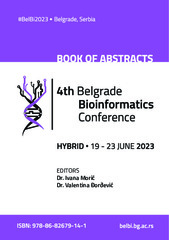Приказ основних података о документу
Numerical and Biological Modeling Approach in the Analysis of the Cancer Viability and Apoptosis
| dc.contributor | Morić, Ivana | |
| dc.contributor | Đorđević, Valentina | |
| dc.creator | Virijević, Katarina | |
| dc.creator | Živanović, Marko | |
| dc.creator | Gazdić Janković, Marina | |
| dc.creator | Ramović Hamzagić, Amra | |
| dc.creator | Milivojević, Nevena | |
| dc.creator | Pecić, Katarina | |
| dc.creator | Šeklić, Dragana | |
| dc.creator | Jovanović, Milena | |
| dc.creator | Kastratović, Nikolina | |
| dc.creator | Mirić, Ana | |
| dc.creator | Đukić, Tijana | |
| dc.creator | Petrović, Ivica | |
| dc.creator | Jurišić, Vladimir | |
| dc.creator | Ljujić, Biljana | |
| dc.creator | Filipović, Nenad | |
| dc.date.accessioned | 2023-08-07T12:20:07Z | |
| dc.date.available | 2023-08-07T12:20:07Z | |
| dc.date.issued | 2023 | |
| dc.identifier.isbn | 978-86-82679-14-1 | |
| dc.identifier.uri | https://belbi.bg.ac.rs/ | |
| dc.identifier.uri | https://imagine.imgge.bg.ac.rs/handle/123456789/2010 | |
| dc.description.abstract | Biomedicine is a multidisciplinary branch of science that requires a clear approach to the study and analysis of various life processes necessary for a deeper understanding of human health. This research focuses on the use of numerical simulations with the aim of an improved comprehension of cancer viability and apoptosis during treatment with commercial chemotherapeutic agents. In recent times, the usage of numerical models was successfully applied to predict the behavior of tumors. This study includes a wide range of numerical results that have been obtained by examining cell viability in real-time, determining the type of cell death and the genetic factors that control these processes. The results of the in vitro test were used to develop a numerical model that provides a new perspective on the proposed problem. In this study, colon, and breast cancer cell lines (HCT-116 and MDA-MB-231), as well as healthy lung fibroblast cell line (MRC-5) were treated with commercial chemotherapeutic agents. The obtained results showed a decrease in viability and the occurrence of predominantly late apoptosis upon treatment, as well as a strong correlation between parameters. A mathematical model was developed and used to gain a better understanding of the investigated processes. This method can accurately simulate the behavior of cancer cells and reliably predict their growth. | sr |
| dc.language.iso | en | sr |
| dc.publisher | Belgrade : Institute of molecular genetics and genetic engineering | sr |
| dc.relation | info:eu-repo/grantAgreement/MESTD/inst-2020/200378/RS// | |
| dc.relation | The authors are grateful for the support of the European Union’s Horizon 2020 research and innovation programme (grant agreement No 952603 (SGABU) | |
| dc.rights | openAccess | sr |
| dc.source | 4th Belgrade Bioinformatics Conference | sr |
| dc.subject | numerical modeling | sr |
| dc.subject | cancer | sr |
| dc.subject | cell viability | sr |
| dc.subject | apoptosis | sr |
| dc.subject | gene expression | sr |
| dc.subject | cytostatics | sr |
| dc.title | Numerical and Biological Modeling Approach in the Analysis of the Cancer Viability and Apoptosis | sr |
| dc.type | conferenceObject | sr |
| dc.rights.license | ARR | sr |
| dc.rights.holder | © 2023 Institute of Molecular Genetics and Genetic Engineering, University of Belgrade | sr |
| dc.citation.epage | 70 | |
| dc.citation.spage | 70 | |
| dc.citation.volume | 4 | |
| dc.description.other | Book of abstract: 4th Belgrade Bioinformatics Conference, June 19-23, 2023 | sr |
| dc.identifier.fulltext | https://imagine.imgge.bg.ac.rs/bitstream/id/315000/BELBI-Abstracts-final-07072023_1-15,86,129.pdf | |
| dc.identifier.rcub | https://hdl.handle.net/21.15107/rcub_imagine_2010 | |
| dc.type.version | publishedVersion | sr |
Документи
Овај документ се појављује у следећим колекцијама
-
Belgrade Bioinformatics Conference
BelBi conferences

